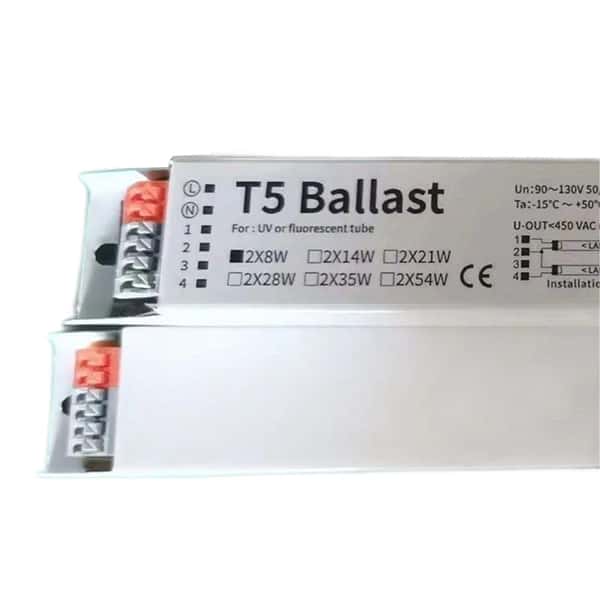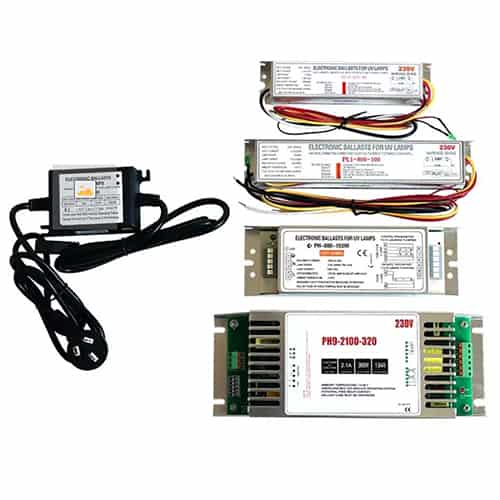People are often unsure whether they can use T5 LED tubes without a ballast. This confusion over compatibility and installation can lead to unnecessary expenses or unsafe installations. The key is to know how they work and when you need a fluorescent ballast and when you don’t.
Yes, you can use T5 LED tubes without a ballast, but only if they are designed for direct wiring. This type of T5 LED tube is often referred to as a ballast-bypass tube. Check the manufacturer’s specifications to make sure the T5 LED tube you choose is capable of operating without a ballast.
Now, let’s talk about when you need a ballast, when you don’t need a ballast and what to consider.
What is a Ballast and How Does it Work?
A lamp ballast is a device used in traditional fluorescent lighting systems to regulate the electrical current and ensure the lamps start properly. When fluorescent lights such as T5 tubes are powered on, they require an initial surge of electricity to create an arc between the electrodes inside the tube. The ballast helps provide this necessary voltage and then regulates the current flow to keep the lamp functioning safely and efficiently.
In short, the ballast prevents the light from drawing too much power, which would otherwise damage the lamp. Traditional T5 fluorescent tubes cannot operate without a ballast because they rely on it to maintain stable electrical conditions.
Can T5 LED Tubes Operate Without a Ballast?
T5 LED tubes are designed to offer a more energy-efficient alternative to traditional fluorescent tubes. Unlike fluorescent tubes, LED technology does not always require a ballast to function. However, not all T5 LED tubes are the same—some are designed to work with an existing ballast, while others are intended for use without one.
The key to whether a T5 LED tube can operate without a ballast depends on the type of tube. Some T5 LED tubes are ballast-compatible, meaning they can be installed as a direct replacement for fluorescent tubes without the need to bypass or remove the ballast. These are often referred to as “plug-and-play” models. On the other hand, there are T5 LED tubes that are specifically designed for ballast-bypass installations. These tubes do not require a ballast at all, as they are wired directly to the main power source.
Only ballast-bypass T5 LED tubes can operate without a ballast. If you have a ballast-bypass tube, the ballast must be removed or bypassed during installation, allowing the LED tube to connect directly to the mains power.
Types of T5 LED Tubes and Their Installation Methods
There are two main types of T5 LED tubes, each with different installation methods: ballast-compatible (plug-and-play) and ballast-bypass (direct wire).
Ballast-Compatible T5 LED Tubes, also known as plug-and-play tubes, are designed to work with the existing ballast in the lighting fixture. These tubes are convenient because they don’t require any modifications to the wiring or fixture. You simply remove the old fluorescent tube and replace it with the LED tube. However, these tubes rely on the functionality of the ballast. If the ballast fails, you will need to replace it, which can increase long-term maintenance costs.
Ballast-Bypass T5 LED Tubes, or direct-wire tubes, are designed to operate without a ballast. During installation, the ballast is either removed or bypassed, and the tube is connected directly to the main power. While this requires rewiring the fixture, it eliminates the need for a ballast altogether. This type of tube is more energy-efficient and lowers long-term maintenance costs because there is no ballast to replace. However, installation can be more complex and may require the help of a professional electrician to ensure the wiring is done safely.
Advantages of Using T5 LED Tubes Without a Ballast
There are several advantages to using a T5 LED tube without a electronic ballast, particularly when it comes to energy efficiency and maintenance.
One of the main benefits is energy efficiency. Ballasts consume power to regulate the current for fluorescent lamps, and even though this amount is small, it adds to the overall energy usage. By removing the ballast, you eliminate this extra energy consumption, making the lighting system more efficient.
Another significant advantage is cost savings. Without a ballast, there are fewer components that can fail or need replacing. Ballasts typically have a lifespan of five to ten years, after which they must be replaced. By bypassing the ballast, you reduce the number of parts that need to be maintained or replaced, leading to long-term savings.
Finally, lower maintenance is a key benefit of using T5 LED tubes without a ballast. Fluorescent lighting systems require regular maintenance to ensure the ballast is functioning properly. When a ballast fails, it can result in flickering lights or even complete outages. With a ballast-bypass LED tube, you eliminate the need for this component entirely, reducing the likelihood of system failures and simplifying maintenance.
Potential Risks and Challenges of Using T5 LED Tubes Without a Ballast
While there are many advantages to bypassing the ballast, there are also some risks and challenges to be aware of.
First, professional installation may be necessary. When bypassing the ballast, you need to rewire the fixture to connect the LED tube directly to the mains power. This process involves removing the ballast and potentially rewiring the socket to ensure proper operation. Incorrect wiring can lead to electrical hazards, such as short circuits or even fires. It is always recommended to hire a licensed electrician to handle the installation if you are unfamiliar with electrical work.
Another potential challenge is ensuring tube compatibility. Not all T5 LED tubes are designed for direct wiring. Installing a plug-and-play tube without a ballast could result in the tube not functioning or even becoming damaged. Always verify that the LED tube is specifically labeled as a ballast-bypass model before installation. Additionally, using the wrong tube could void any warranties or lead to safety issues.
How to Install a T5 LED Tube Without a Ballast
Installing a T5 LED tube without a ballast requires a few basic steps, but should always be performed according to the manufacturer’s instructions and local electrical codes.
First, turn off the power at the circuit breaker to ensure safety. Next, remove the fluorescent tube and open the fixture to access the ballast. Disconnect and remove the ballast by cutting or detaching the wires. Then, connect the wires directly to the mains power, following the instructions provided with the LED tube. Finally, install the LED tube into the fixture and restore power to test the installation.
Always double-check the wiring and consult a professional if you’re unsure about the process to avoid any mistakes or hazards.
Final Words:
You can use T5 LED tubes without a light ballast as long as they are designed for direct wiring. This option can provide increased energy efficiency, reduced maintenance, and cost savings. Be sure to pay attention to compatibility and how to install them. When in doubt, follow the manufacturer’s instructions or consult a professional for installation.




